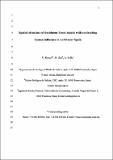Por favor, use este identificador para citar o enlazar a este item:
http://hdl.handle.net/10261/23994COMPARTIR / EXPORTAR:
 SHARE SHARE
 CORE
BASE CORE
BASE
|
|
| Visualizar otros formatos: MARC | Dublin Core | RDF | ORE | MODS | METS | DIDL | DATACITE | |

| Título: | Spatial structure of deciduous forest stands with contrasting human influence in northwest Spain |
Autor: | Rozas Ortiz, Vicente Fernando CSIC ORCID; Zas Arregui, Rafael CSIC ORCID; Solla, Alejandro | Palabras clave: | Geostatistics Spatial autocorrelation Moran’s I coefficient Spatial pattern Null models Random labelling Ripley’s K function Stand structure |
Fecha de publicación: | may-2009 | Editor: | Springer Nature | Citación: | European Journal of Forest Research 128 (3): 273-285. | Resumen: | Five contrasting deciduous forest stands were studied to characterize the spatial structural variability in human-influenced forests. These stands are representative of cultural forest types widely represented in western Europe: one plantation, two coppices, one wood-pasture forest and one high forest stand. All stems with DBH > 5 cm were measured and mapped, and stem DBH distributions, spatial structure of DBH, spatial point patterns and spatial associations were analysed. Spatial autocorrelation for DBH was calculated with Moran’s I correlograms and semivariograms. Complete spatial randomness hypothesis for spatial point patterns, and both independence and random labelling hypotheses for spatial associations were analysed using Ripley’s K function. The results showed that tree sizes were conditioned by particular former management systems, which determined unimodal symmetric, positively skewed or compound DBH distributions. Spatial structure was more complex when human influence became reduced. Coppice stands showed clumped spatial patterns and independence among size classes, as a consequence of sexual and vegetative establishment of new stems in open areas. The largest clumping intensity was observed in the wood-pasture with an intermediate disturbance frequency and low inter-tree competition. The high forest stand displayed spatial traits consistent with the gap-dynamics paradigm, such as clumping of smaller trees, random arrangement of larger trees, negative association between juveniles and adults, and high structural heterogeneity. It can be expected that after cessation of human interference, coppices and wood-pastures would evolve to a more heterogeneous structure, probably with a higher habitat and species diversity. | Versión del editor: | http://dx.doi.org/10.1007/s10342-009-0263-9 | URI: | http://hdl.handle.net/10261/23994 | DOI: | 10.1007/s10342-009-0263-9 | ISSN: | 1612-4669 |
| Aparece en las colecciones: | (MBG) Artículos |
Ficheros en este ítem:
| Fichero | Descripción | Tamaño | Formato | |
|---|---|---|---|---|
| Rozas_Spatial_structure...pdf | 438,92 kB | Adobe PDF |  Visualizar/Abrir |
CORE Recommender
SCOPUSTM
Citations
27
checked on 22-abr-2024
WEB OF SCIENCETM
Citations
22
checked on 27-feb-2024
Page view(s)
340
checked on 24-abr-2024
Download(s)
301
checked on 24-abr-2024
Google ScholarTM
Check
Altmetric
Altmetric
NOTA: Los ítems de Digital.CSIC están protegidos por copyright, con todos los derechos reservados, a menos que se indique lo contrario.
